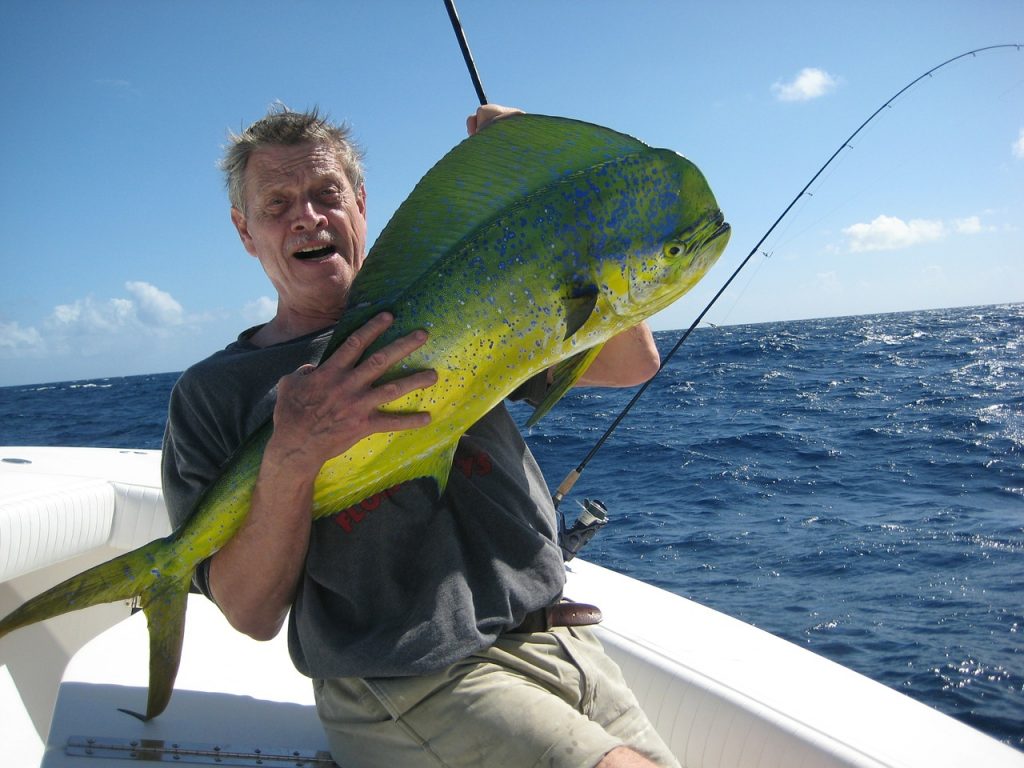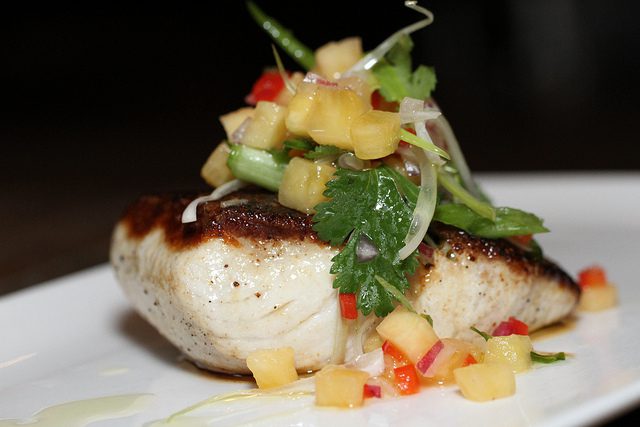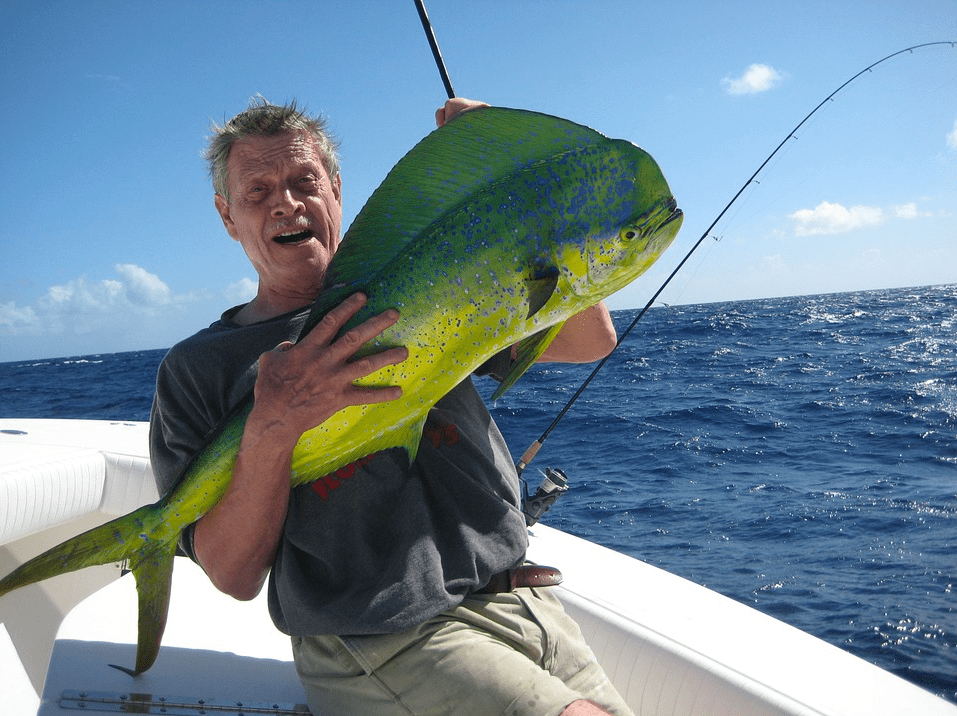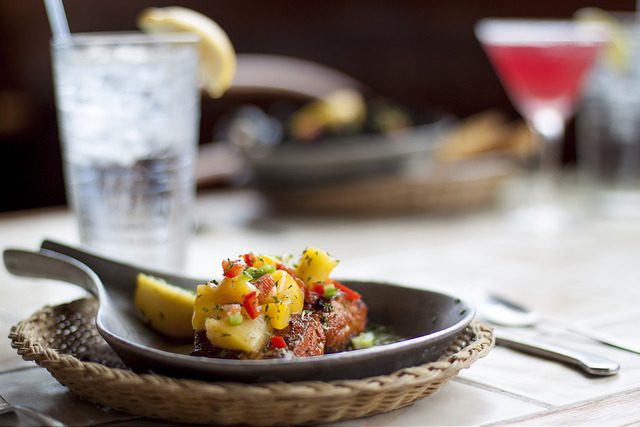Mahi Mahi is a delicious and healthy fish that you can prepare just about anywhere. It is a fantastic addition to your cooking repertoire as well as an excellent choice for the environmentally conscious. If you’re looking for a new yummy fish to try or want more fish in our diet, mahi-mahi is a great place to start. Let’s examine this delectable dolphin fish. Then you can read our recipe for a nutty (the good kind), crunchy yet tender mahi-mahi dish.
Strength for the Fisherfolk of the World
Mahi is Hawaiian for “strong.” So when they call something “strong-strong,” you know they mean it. The mahi-mahi gets its name from both its muscular body and its hardiness. It lives all over the world and can survive in both tropical and subtropical climates. On top of all that, it has very few predators because of how fast it can swim.
Traditionally it is known as a dolphin fish in English speaking cultures, but don’t let that disturb you. They are, of course, not dolphins nor are they an important food source for any species of dolphin. It isn’t sure why they got the dolphinfish name, but there are a few theories.
Some think it’s because the mahi-mahi seems to communicate with one another in high pitched noises as dolphins do. They are also quite large so that some anglers may have mistaken them for or compared them to small dolphins. Either way, markets quickly adopted the mahi-mahi name as an alternative to avoid confusion. Most people in developed nations wouldn’t want to eat a dolphin!
As far as non-English speaking cultures, the fish is also known as “Dorado” or “golden” by Spanish speaking fisherfolk. This is because the Mahi’s brilliant scales give off a golden sheen when out of the water. In some cases, the word “Dorado” was also used to describe dolphins, so there’s another theory on where the weird name came from.
Health Benefits of the Mahi-Mahi
Fish is a widely popular health food these days, and for good reasons. They are high in many vital nutrients and lack some of the more harmful substances like fat and cholesterol in great amounts. The mahi-mahi, in particular, has a lot of great stuff for you when compared to other fish.
Protein
Mahi is a significant source of protein, like most fish. But unlike most fish, mahi-mahi has a meager amount of fat in its meat. Remember “strong-strong”? This fish is mostly muscle. Protein is vital for a variety of body functions and aids in the development of muscle mass. Eat mahi-mahi, and you’ll get strong-strong.
Vitamins
Mahi is high in vitamin B-5 and B-6. These vitamins regulate your mood and metabolism, so the more you get, the better you will feel both physically and mentally. These vitamins also help with your hormone production to keep your body working in tip-top shape. A single serving of mahi-mahi contains a quarter of your recommended B-5 and over half of your recommended B-6!
Minerals
Along with vitamins, mahi-mahi meat also provides your body with vital minerals. It is high in potassium, which supports heart and muscle function. A reasonable level of potassium also lowers your blood pressure, which decreases your risk of heart disease.
Mahi-mahi also contains the somewhat rare mineral selenium. This mineral does great things for your immune system, helping you fight off infectious diseases. It also plays critical roles in reproduction processes, thyroid hormone metabolism, synthesis of DNA, and protection from free radicals which cause oxidative damage.
Things to Watch Out: Mercury
As with many ocean fish, mahi-mahi contains a not-insignificant amount of mercury. It is rated as a “moderate mercury” fish by the Natural Resources Defense Council. That may sound bad but consider that this ranking is second to lowest in the systems ranking out of four.
The Natural Resources Defense Council recommends eating six servings or fewer of mahi-mahi each month. This is an overly cautious guideline, but a good one to follow if you eat fish often, or if the source of your mahi-mahi is suspect. Keep in mind there has been much more controversy over tuna’s mercury content, and that is one of the most widely consumed fish there is.
Mahi-Mahi’s Environmental Impact
It’s no secret that humanity has a negative impact on the world’s oceans, and the fishing industry is one of the worst perpetrators. Overfishing and damaging fishing practices can devastate both fish populations and the animals that rely on the fish as a food source. That’s why there’s such a thing as “dolphin-safe tuna” now.
Fortunately, mahi-mahi and the fishing of it has a very little impact on the environment compared to other fish staples. First of all, they are plentiful. The spawn in vast numbers and like we talked about earlier, they live all over the world. This does not mean that they couldn’t be overfished, it just means that it would be difficult and at present, they are considered a species of “least concern” regarding the endangered species list.
Furthermore, depending on how it is caught, mahi-mahi fishing does not severely affect other fish populations. As rated by conservation authorities like the Environmental Defense Fund, mahi-mahi caught by trolling and line/pole have little to no impact on other sea life.
However, beware of mahi-mahi caught with “longline fishing” which causes a lot of bycatch; injuring or killing birds, sea turtles, and sharks. Make sure you know where your mahi-mahi is coming from, just like the rest of your food.
Mahi Mahi Recipies
Now that you know how great mahi mahi is let’s look at some recipes you can use to make the most out of it.
Baked Mahi Mahi with Nutty Breading and Honey Soy Glaze
This robust yet straightforward recipe has a zesty crunch with a tender and moist fish core.
Ingredients
- 1 pound (450 g) of mahi mahi fillets: How many is up to you
- 1 ½ cups (350ml) cornflakes: Any brand will do!
- 1 cup (240ml) nuts: You can use macadamia nuts, pecans or walnuts.
- Sea salt and pepper
- Cooking spray
- Honey soy glaze: for this, mix
- ? cup (80ml) honey
- ? cup (80ml) soy sauce
- 2 (30ml) teaspoons dry mustard (more if that is your taste)
Directions
You can mix the glaze beforehand or do it while to fish bakes.
- Preheat oven to 350 degrees F (175 degrees C)
- Chop nuts until coarse. You may want to use a food processor if you have one available to you.
- Crush up the corn flakes so that they are in small pieces, but not powdered. You can toss them in with your nuts into the food processor. Either way, mix with the nuts when finished.
- Add the salt and pepper, then spread the mixture out onto a platter.
- Roll your fillets on the platter to bread the fish in the nut, flake, salt and pepper mixture. You may want to press down on the fillets so that the mixture sticks to them and doesn’t fall off.
- Spray a baking pan with the cooking spray.
- Lay the fillets onto the baking pan with at least an inch separating them. They should not be touching.
- Bake for ten minutes.
- Check the fillets. They should be moist still and delicate. No need to cook until they are dry.
- Put the fillets on a plate along with any other side dishes. Simple steamed brown rice is a good grain accompaniment.
- Drizzle the fillets with your glaze. You may want to pour some onto an empty portion of the plate for dipping.
- Enjoy!
Try pairing it with aromatic white wine (if you’re old enough!) as it won’t overpower the Mahi Mahi’s delicate taste. A sauvignon blanc should go quite well with your dish.
Simple Baked Mahi Mahi
Want something a bit simpler? Try this baked mahi mahi dish.
Ingredients
- 2 pounds (900 g) of mahi mahi fillets: How many is up to you
- One lemon: Juiced!
- ¼ teaspoon (5ml) garlic salt
- ¼ teaspoon (5ml) black pepper
- 1 cup (240ml) mayonnaise: Again, any brand is OK!
- ¼ cup (60ml) chopped white onions
- Breadcrumbs
Directions
This is a quick one and should take at most 45 minutes.
- Preheat oven to 425 degrees F (220 degrees C)
- Rinse the fillets and place them in a baking pan.
- Season with lemon juice, salt, and pepper.
- Mix the mayo and chopped onions and spread the mixture onto the fish.
- Sprinkle with breadcrumbs.
- Bake for 25 minutes.
- Serve and enjoy!
This recipe stays tender and doesn’t dry out the fish. The flavor is good but not overly strong so that you can pair it with just about anything!
Deliciously Strong
Mahi mahi is a delicious and healthy fish that is not only good for you but good for the planet as well. You owe it to yourself and your family to try one of these delicious recipes out today!










1 Comment
Yeap. I totally agree with you. Health is wealth. I love fish & love to catch fish also. Great thinking. Thanks.